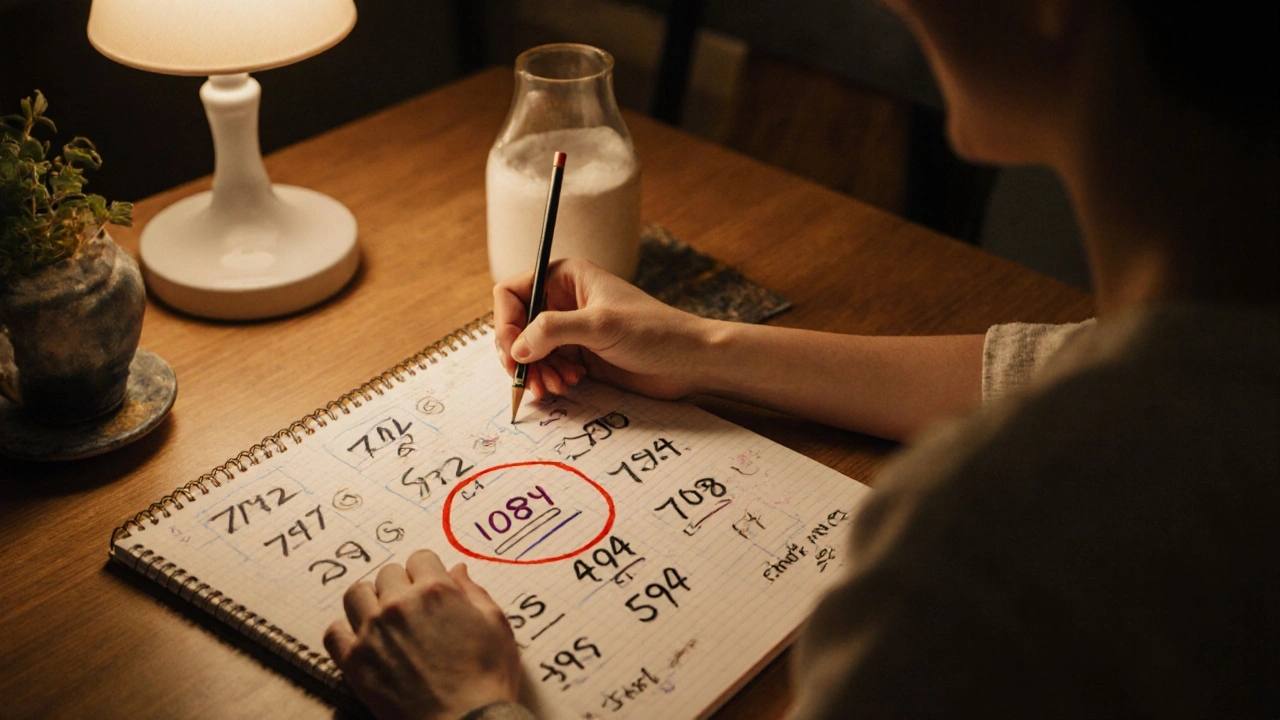Have you ever watched someone guess your secret number before you even finish thinking it? Or seen a stranger pull a card out of a shuffled deck and say, "This is the one you picked," even though you never told them? That’s not mind reading. It’s math magic trick - and it’s easier to learn than you think.
How Math Magic Tricks Actually Work
Math magic tricks aren’t about secret hand movements or hidden cameras. They’re built on patterns you already know - addition, multiplication, subtraction - but arranged so they feel impossible. The trick isn’t in the math. It’s in the setup.
Take this classic: Ask someone to pick any three-digit number where the first and last digits differ by at least two. Let’s say they pick 742. Then tell them to reverse it (247), subtract the smaller from the larger (742 - 247 = 495), and then reverse that result (594). Now add the two numbers together: 495 + 594 = 1089. No matter what number they started with - as long as it follows the rule - the answer will always be 1089.
It feels like magic because they didn’t see the pattern coming. But if you break it down, it’s just algebra hiding in plain sight. The math doesn’t lie. And that’s why it works every single time.
Why These Tricks Feel So Powerful
Our brains are wired to look for patterns - but we’re terrible at spotting ones we didn’t create ourselves. When someone says, "Think of a number," and then somehow ends up with your exact thought, your brain doesn’t think, "Oh, this is a predictable sequence." It thinks, "How did they know?"
That’s the psychology behind it. The trick isn’t just math - it’s misdirection. You’re focused on the number you picked, not the steps that follow. You’re not thinking about how reversing digits affects place value. You’re just thinking, "I chose this randomly. They couldn’t have known."
That’s why math magic tricks work better than card tricks for beginners. You don’t need sleight of hand. You don’t need to practice shuffling. You just need to know the steps - and how to ask the right questions.
Three Math Magic Tricks You Can Learn Today
Here are three foolproof tricks you can try right now - no props needed.
- The Always 5 Trick
Ask someone to pick any number. Double it. Add 10. Divide by 2. Subtract the original number. The answer? Always 5. It works with 3, 17, 102, or 0. Try it. The math: (2x + 10)/2 - x = x + 5 - x = 5. - The 1089 Trick (The Classic)
Pick a three-digit number with different first and last digits. Reverse it. Subtract the smaller from the larger. Reverse the result. Add it to the original difference. Always 1089. This one works because of how base-10 place values behave when digits are flipped. - The Birthday Guess
Ask someone to multiply the month of their birth by 5. Add 6. Multiply by 4. Add 9. Multiply by 5. Then add the day of their birth. Finally, subtract 165. The last two digits are the day. The first one or two digits are the month. It’s just a clever way of encoding numbers into a formula. For example, if someone was born on March 15: (3×5+6)×4+9)×5+15-165 = 315. 3 = March, 15 = day.

What Makes a Good Math Magic Trick?
Not all number tricks are created equal. A great one has three things:
- It’s foolproof. No exceptions. If it fails once, people won’t trust it.
- It’s fast. You don’t want to be scribbling on napkins for five minutes. The whole thing should take under 30 seconds.
- It hides the math. The person should never suspect they’re doing algebra. If they catch on, the magic dies.
That’s why the 1089 trick is perfect. It uses subtraction and reversal - things anyone can do with a calculator or pencil. But the result? Unpredictable. Until you know the rule.
Why Math Magic Tricks Are Better Than Card Tricks for Beginners
If you’ve ever tried learning card tricks, you know how frustrating it can be. You spend hours practicing the double lift, only to mess it up in front of your cousin at Thanksgiving. Math tricks? No hands. No cards. No pressure.
You can do them anywhere. At a coffee shop. On a bus. In a Zoom call. All you need is someone willing to think of a number. And once you get good at the patter - the way you say it, the pauses, the fake surprise - you’ll have people asking, "How did you do that?"
And here’s the best part: you can explain how it works afterward. Most magicians never reveal the secret. But with math magic, you can say, "Here’s why it works," and turn a trick into a teaching moment. That’s why teachers use these in classrooms. It’s fun, it’s surprising, and it makes math feel alive.

Common Mistakes People Make
Even simple tricks can fall apart if you’re not careful.
- Letting someone pick a number like 111 or 555. The 1089 trick fails if the first and last digits are the same. Always say, "Pick a number where the first and last digits are different by at least two."
- Going too fast. If you rush through the steps, people get lost. Pause after each instruction. Let them do the math. Don’t do it for them.
- Trying to impress too many people at once. These tricks work best one-on-one. In a group, someone else might blurt out the answer - or someone might not follow along.
Also, avoid using calculators unless you have to. Handwriting the numbers makes it feel more personal. It also makes the trick harder to reverse-engineer on the spot.
Where to Go From Here
Once you’ve mastered these three, there are dozens more. Some use prime numbers. Others use modular arithmetic. One famous trick even predicts the sum of five randomly chosen numbers before they’re written down.
You can find books like The Magic of Numbers by Michael Shermer or online videos from math educators like Numberphile that break down these tricks with real proofs. But you don’t need to be a math genius. You just need to practice saying the words the right way.
Try this tonight: Ask a friend to pick a number. Walk them through the Always 5 trick. Watch their face when you say, "It’s 5," before they even finish calculating. That’s the moment magic happens - not because of anything supernatural, but because you understood the pattern better than they did.
Frequently Asked Questions
Can math magic tricks work with decimals or negative numbers?
Most classic math magic tricks are designed for whole numbers between 1 and 999. Decimals and negatives break the patterns. For example, the 1089 trick won’t work with 2.5 or -342. Stick to positive integers with three digits for reliable results.
Do I need to memorize all the steps?
No. Write the steps on a small card if you need to. The trick isn’t about perfect recall - it’s about delivery. Say the instructions clearly. Pause. Let them think. Most people forget the steps anyway once they’re focused on their own number.
Why does the 1089 trick always give the same result?
It’s because of how subtraction and digit reversal work in base-10. When you subtract a reversed three-digit number from the original, the middle digit always becomes 9, and the outer digits add up to 9. Reversing and adding forces the sum into 1089. It’s not magic - it’s number theory.
Are math magic tricks used in real magic shows?
Yes. Professional magicians like Derren Brown and Penn & Teller use math-based illusions because they’re impossible to detect. A card trick can be rigged. A coin vanish can be exposed. But a number that always becomes 1089? There’s no trick - just math. That’s why it’s so powerful.
Can kids learn and perform these tricks?
Absolutely. Kids as young as 8 can do the Always 5 trick. It’s a great way to make arithmetic fun. Many elementary teachers use these tricks to get students excited about math. The best part? Once they learn it, they’ll want to teach it to their friends.


Ray Htoo
November 19, 2025 AT 03:39Man, I tried the 1089 trick on my nephew last night-he was five, didn’t even know what subtraction was, but he loved watching me scribble numbers. By the end, he was yelling "MAGIC!" like a tiny wizard. Then he tried it on his stuffed dinosaur. It worked. The dino’s now officially a math prodigy.
Natasha Madison
November 20, 2025 AT 04:39This is a distraction tactic. The government uses these "magic tricks" to keep people from noticing that all numbers are controlled by the Federal Reserve’s quantum algorithm. 1089? That’s not math-it’s a coded frequency. They want you to believe in patterns so you won’t question the real system.
Sheila Alston
November 21, 2025 AT 03:04How can you call this "magic" when it’s just basic arithmetic? People need to stop glorifying simple algebra like it’s some kind of enlightenment. If you can’t do basic math without a trick, maybe you shouldn’t be allowed to use a calculator. This is just pandering to people who think math is a party trick instead of a discipline.
sampa Karjee
November 21, 2025 AT 17:45These tricks are trivial. In India, we teach children modular arithmetic before they learn multiplication. The 1089 result is a trivial consequence of base-10 positional notation. You call it magic? It’s Grade 5 number theory. If you need to impress people with this, you’re not doing math-you’re performing for the math-illiterate.
Patrick Sieber
November 22, 2025 AT 14:10Love this. I’ve used the Always 5 trick on my students for years. The best part? When they realize they just did algebra without realizing it. One kid said, "So math isn’t just boring stuff in textbooks?" That’s the win. No flash, no cards, just pure "ohhh" moments. Teachers should use this more.
Kieran Danagher
November 22, 2025 AT 17:03So you’re telling me the reason I can’t get a date is because I haven’t mastered the birthday trick? Brilliant. Next you’ll tell me that if I reverse my ex’s phone number and add 1089, she’ll magically come back. I’ll start with the Always 5 trick. First step: ask her to pick a number. Second step: wait for her to ask why I’m doing math during small talk.
OONAGH Ffrench
November 24, 2025 AT 05:15It’s not magic. It’s structure. The mind seeks mystery where there is only order. The trick reveals nothing about the person picking the number-only about the rigidity of number systems. We are surprised not because the math is hidden, but because we refuse to see how predictable we are. The real magic is how little we understand ourselves.
poonam upadhyay
November 24, 2025 AT 09:52Okay but have you considered that these "tricks" are actually just low-effort psychological manipulation disguised as education?? Like, why are we encouraging people to "perform" math like it’s a carnival game?? It’s not empowering-it’s infantilizing! And the fact that people think "oh it’s just algebra" means they’ve never actually been taught why place value matters!! You can’t just slap on "reverse digits" and call it a lesson!! This is why kids hate math!!